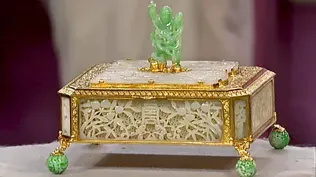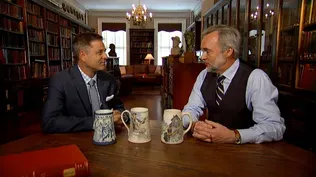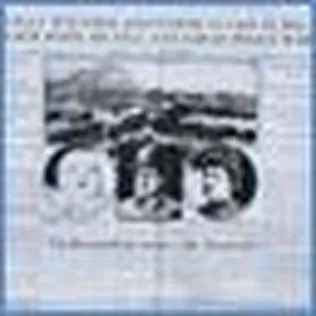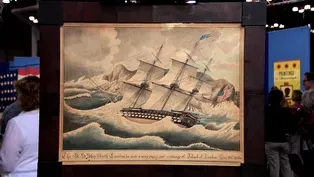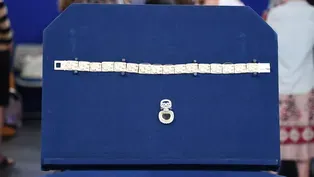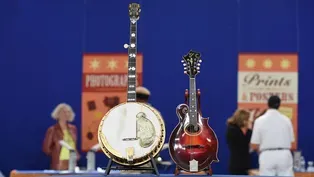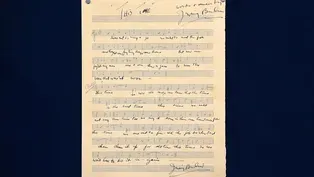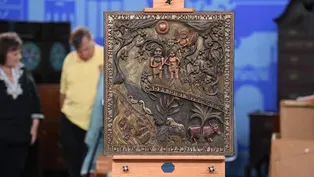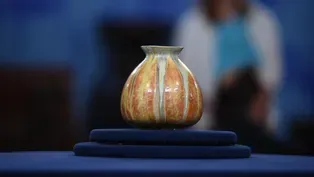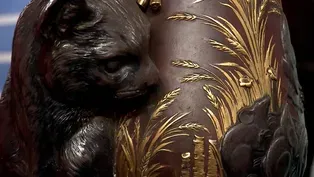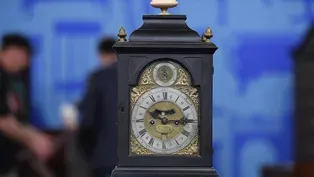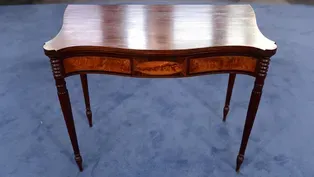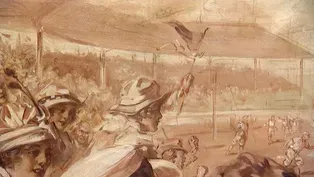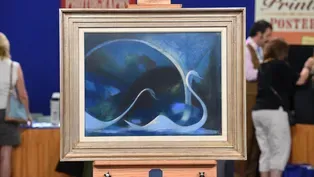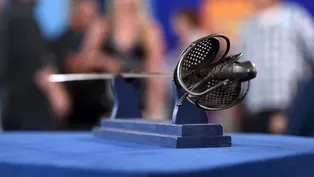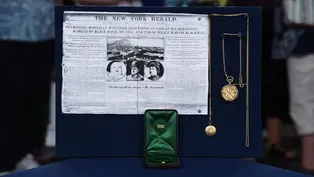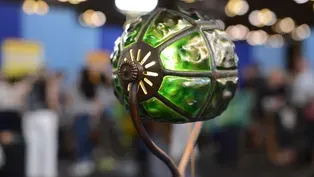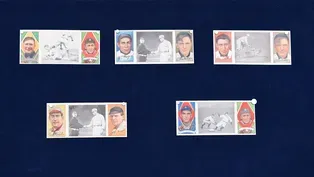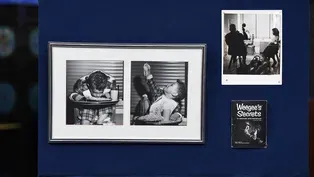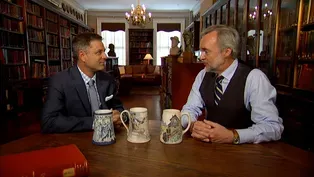

New York City, Hour 3 (2015)
Season 19 Episode 3 | 53m 2sVideo has Closed Captions
In New York City, Hour 3, highlights include a Tiffany watch and an Irving Berlin script.
ANTIQUES ROADSHOW stops in NYC where host Mark L. Walberg joins appraiser Nicholas M. Dawes at the Salmagundi Club to learn about porcelain mugs created by former artist members.
Funding for ANTIQUES ROADSHOW is provided by Ancestry and American Cruise Lines. Additional funding is provided by public television viewers.

New York City, Hour 3 (2015)
Season 19 Episode 3 | 53m 2sVideo has Closed Captions
ANTIQUES ROADSHOW stops in NYC where host Mark L. Walberg joins appraiser Nicholas M. Dawes at the Salmagundi Club to learn about porcelain mugs created by former artist members.
How to Watch Antiques Roadshow
Antiques Roadshow is available to stream on pbs.org and the free PBS App, available on iPhone, Apple TV, Android TV, Android smartphones, Amazon Fire TV, Amazon Fire Tablet, Roku, Samsung Smart TV, and Vizio.
Buy Now

ANTIQUES ROADSHOW 2025 Tour!
Enter now for a chance to win free tickets to ANTIQUES ROADSHOW's 2025 Tour! Plus, see which cities we're headed to!Providing Support for PBS.org
Learn Moreabout PBS online sponsorshipWelcome to Antiques Roadshow from New York City.
WOMAN: It was kind of the ugly duckling.
Nobody really wanted it.
I think it's beautiful.
You got the booby prize.
WOMAN: These are pictures of my husband when he was about two years old taken by the photographer Weegee.
Well, it looks like he's having a lot of fun.
I saw your knees go out a little bit there for a second.
You did?
What treasures did we find in the Big Apple?
Stay tuned.
Welcome to Antiques Roadshow.
Hi, I'm Mark Walberg, this week in New York.
You know what they say about New York City: if you can make it here, you can make it anywhere.
And that may be true for people, but what about old treasures?
Take a look at some of the finest objects with New York origins we found at Roadshow today.
WOMAN: This was my grandmother's vase.
My mother got it when my grandmother died, and then when my mom passed away, I got it.
APPRAISER: You said you had to talk to your brothers and sisters about this?
Well, it was not really a discussion.
It was kind of the ugly duckling.
Nobody really wanted it.
I loved it, I think it's beautiful, so... You got the booby prize.
Yeah, more or less.
I don't think it's a booby prize, though.
I think it's beautiful.
Well, it is beautiful, certainly to me it is, and there's a great story behind it as well.
The vase was made actually in New York.
It was?
It was made sometime between 1898 and about 1910.
It was made out in the Hamptons by Theophilus A. Brouwer.
And Brouwer was an odd guy.
He was a renaissance man.
He was an architect, he was a painter, he made reinforced cement lawn figurines, he built his own house with reinforced cement, but the main thing he's remembered for is his entry into the ceramic arts world.
And art pottery was big around the turn of the century, and Brouwer was one of the major forces in a very small way.
He developed this thing called fire painting, and if you look on the bottom of your piece, it's not signed by Brouwer, but it says "Flame," and that's a shape number-- I'm not sure exactly what it denotes aside from the shape of the piece.
Maybe it's the 65th piece he tried with this technique.
And it shows two flames.
I saw that and I actually tried to research that over the years and I've never been able to come up with anything.
Well, he called it flame painting because he would get a vase that would be white, and he'd grab it with a pair of tongs and dip it into a solution and then go into an open flame and hold the vase in front of the open flame and let the flames lick over the surface of the piece.
And if you see this, you can see where the flames have played on the surface of the pot, okay?
And orange-- he put it back in, he'd know how long to hold it there.
Green-- he put it back in another time, he'd wait again.
He can control the process of letting the flames influence the color of the glazing on his pots.
So not only was he able to control the color itself, but certainly the intermodulation of various colors imparted by the fire onto the raw glaze.
So that's a great thing, and he's known for his flame painting.
But more importantly about this piece, because all of his flame pieces have these colors we're talking about, but these stripes running down the side, I've never seen that before, and I've probably seen a couple hundred pieces of Brouwer's work.
His work is in many of the famous museums in America, including the Metropolitan Museum of Art.
So he's a big deal, and this is, aside from being a beautiful example of the work of a master from the Arts and Crafts period, it's also an unusual example to have this technique so controlled in the face of the fire.
There is a small chip on the rim, but it really doesn't matter much.
It's a fairly lightweight biscuit, so it does tend to damage.
That's why I don't put anything in it.
I've never put anything in it, water or flowers or anything.
That's wise of you.
I would say at auction today, worth somewhere between $5,000 and $7,000.
Seriously?
Wow, okay.
Not so ugly after all, is it?
I'm a Long Island girl, so knowing it's local and is staying local is pretty cool.
WOMAN: This particular piece has been in our family for as long as I can remember.
When I was a little girl, this lamp lived in my grandmother's home.
We used to love playing with it.
When it was lit, we would call it the brain lamp.
The brain lamp?
The brain lamp, yes.
I understand why.
We also used to do a lot of dressing up as kids, and we would, like, turn it so that we could also use it as a spotlight for our performances.
So it's a very heartfelt piece for our family, so... Well, there was a glass called brain glass.
Really?
Yes, but this isn't it.
Oh, okay.
This is actually a turtleback tile iridescent glass, and the glass is thinner than you would see in other items of bigger form.
Little bit thin.
It's usually not signed.
I will never say never, but it's usually not signed.
And this is a bronze vase, patinated bronze all the way down to the feet with the lily pad.
The good news is, it is Tiffany.
Oh, my God!
Oh, Kathy, that's fantastic!
That's the good news.
Okay, okay.
And the bronze bottom does have on the foot the Tiffany Studios mark, and this lamp is circa 1910.
Now, this chain has been put on here later.
This is a process that can be reversed to make it the way it was originally, which should get done to the piece.
All right.
That does hurt the value a little bit.
With regard to replacing the chain, it wouldn't be very expensive.
My guess is it would be a few hundred dollars.
And it would be specifically a Tiffany chain, correct?
You would have to take it to a Tiffany specialist to get the specific Tiffany piece.
As far as increasing the value on this piece, it would probably increase it maybe by $500 or $600.
It wouldn't be a huge amount.
Great.
Now, I found a couple auction records.
This was very difficult to find.
It's extremely rare.
And I would say today, in a retail market, you might find this piece at $30,000 to $40,000.
Oh, my gosh!
Wow... wow!
Oh, my gosh.
Kathy, thank you so much.
I can't believe it!
Wow.
When you came up to the booth and I saw that little box and it said "Tiffany and Company" and I could tell it was from the turn of the century, I was pretty intrigued to see what was inside.
So tell me a little bit about the watch and the history of it.
The watch was presented to Giuseppe Petrosino by the Italian government for his service to their country in preventing crime or apprehending criminals.
And he was a New York...
He was a New York City lieutenant in the New York City police department, and he was, from what I understand, the only New York City police officer that was ever assassinated in a foreign country.
And how did you come about the watch and all the paperwork?
Mr. Petrosino's granddaughter is a very close friend of the family, and she passed it along to me when she saw that I had an interest in the family genealogy.
The watch is from Tiffany and Company.
This is called a three-quarter plate movement.
It's a large, 18-karat, mint-condition gentleman's Sunday-going- to-church-type watch.
Really?
A great presentation watch.
The presentation that's on the back of the watch, which you hadn't been able to get open... No, I wasn't, and I was afraid, really, to open it.
The presentation is from the Department of the Interior of Italy to Giuseppe, and that was dated in 1908.
Now, the locket was presented to his wife in 1909 after his assassination, and inside the locket is his picture.
How did the locket get to his wife?
Was that given by the Italian government?
See, I'm not sure.
At the time, it could have been given by the police department in New York City.
Because it's written in Italian, so I would imagine it was given by... Well, at the time, he was actually the head of what they call, like, the Italian Detective Squad.
It might have had a different name to it, but it was something to that effect.
There was eventually a movie made about him.
Supposedly in his day, he wore many costumes so that people wouldn't see him.
He was a regular Sherlock Holmes of the United States.
And what was the name of the movie?
I believe it was called The Black Hand.
Okay.
It's an amazing piece of New York City history.
The watch, the locket, the box, when you add all of it together, you've got Tiffany collectors, you've got pocket watch collectors, you've got just a monstrous amount of police and just any sort of collector of New York memorabilia.
So the value of a watch with the locket and all the accompanying paperwork, at auction, probably of course in New York City, since it's such a New York piece of memorabilia, it probably could bring somewhere in the $20,000 or greater price range.
Wow.
The sky could be the limit if you had a few collectors that would want a piece of just unbelievable New York City history.
WOMAN: This belonged to my mother-in-law.
It might have been her mother's before that, but I'm not sure.
She was downsizing, and this didn't fit into the apartment she was moving into, and so she gave it to me.
Do you have any idea what you have?
Well, I looked online a little bit.
It looked like it might be from New England, Federal period.
I saw similar ones to it, and that's all I know.
Well, I'll tell you, you have brought in a Federal period card table.
They would have called it a gaming table.
The family that had this might have had a pair-- they came in pairs.
It looks like it's made around 1800.
Okay.
But then, on a scale of one to ten, you have one, which the tables were just plain fronts.
You have two, three, four with some inlay.
And then you have eight, nine, ten with really amazing veneering, turning, that kind of make that difference between an average piece and a great piece.
This tapered foot is probably the narrowest that I've seen.
It's so tiny.
It comes down to a little, wonderful turning, swells up in this kind of like a balloon shape.
It's actually two turned rings, and then the legs are reeded, and they actually swell, and then you have a turning just above that.
And then one little detail that's so wonderful is the fact that this banding that goes across the front goes around the leg.
Then the upper part of this outset pilaster, this leg turning, is kind of spool turned.
And then you have banding on the edge of rosewood against the mahogany.
And on the front, you have this serpentine, wonderful curve, which is followed by the line at the top.
And these flanking, flame birch panels.
So this is birchwood from New Hampshire, probably.
The centerpiece is flame birch.
It's really figured, highly figured.
It is as good as you can get for flame birch.
Around the flame is this wonderful light and dark stringing, contrasting inlay.
So you have these two panels: the oval with flame birch, the rosewood around that, and then the mahogany.
And it opens up, of course, with this back leg swinging out to a place to put candlesticks, play cards.
You see this?
These actually are matched, bookmatched, okay?
Now, let's close it back up.
I'm going to show you something, though.
I'm going to have to tip it this way.
That crackle?
Yes.
That wasn't crackle back about 80 years ago or 60, when that was fixed.
It would have been a painted-on surface to cover up a repair.
Okay.
So what they did is, look, I looked at this just the morning, I was looking at it, and they actually brushed on to cover up that patch of wood.
See this muddy kind of wood?
Yes.
That's all brushed over the original wood, as well as the replaced wood.
To hide it?
To hide it, yeah.
But if anybody were to look quickly, they'd say, "Oh, the top's replaced," but it's not.
It just looks replaced because they were trying to match it up.
Okay.
Bottom line is, it's a Federal card table, it's very high quality, it does have that patch, but because it can be explained and the wood matches, you know it's okay.
The market for Federal card tables has gone down.
This table is a Federal North Shore card table, possibly Portsmouth, New Hampshire, which would help.
I don't know, but it's really high end.
With this repair, with the market the way it is, an auction estimate on this today would be $2,000 to $2,500, in that range.
Ten to 15 years ago, this would have been $8,000 to $12,000.
Okay.
You know what, I love the table either way, and now I know a lot more about it.
WOMAN: Saw it at an estate sale in New Jersey, and I forced my son to join me, much against his will.
And he is a big Yankees fan, and so we walked in, and there was this painting.
He was very interested in it because it was Yankee Stadium, and I thought it was a very interesting painting just in and of itself.
I agree with both of you.
It's very interesting aesthetically, the subject matter is great.
You mentioned the artist, Howard Chandler Christy.
The painting is an oil on canvas, and it is an early view of baseball.
What could be more American than baseball?
Howard Chandler Christy, of course, was one of the great American illustrators.
He was born in 1872, lived until 1952.
Early on, he studied with William Merritt Chase in New York.
He was originally from Ohio.
He went back to Ohio after studying in New York, but then ultimately came back to New York in 1915.
The way that you have the circular roof line may be more consistent with the Polo Grounds than Yankee Stadium.
So I think we'll leave that open as to the exact location.
What did you pay for it?
I paid about $250.
$250, well that's not a lot of money.
I think it's a good buy.
I had to consider that carefully.
I can understand that.
Have you enjoyed it since?
Very much.
Well, we think that in today's market, if your Howard Chandler Christy painting was offered at auction, the value is $15,000 to $25,000.
Oh, my God.
Oh, my God!
Oh, my God, wow.
That's amazing.
I'm in shock.
Wow.
WOMAN: This is a hand-written piece of music by Irving Berlin that my mother found while rifling through some old family photographs.
It was nestled in with the family of my great-grandfather, who is Ted Wallerstein.
He was the president of Columbia Records for a while in the 1940s.
And I guess we just kind of had it lying in one of our drawers of family albums.
And how long ago did she find it?
I think she said about ten years ago, something along those lines.
We've had it tucked away inside one of our drawers, you know, where someone wouldn't be able to find it, trying to keep it safe.
My mother and I haven't been able to find if the song was ever recorded anywhere.
All we really know is that it was written by Irving Berlin.
Your great-grandfather, he was the chairman of the board at Columbia Records, and he was responsible for signing Frank Sinatra.
Was he really?
So the chairman of the board discovered the Chairman of the Board.
That's incredible.
That is absolutely incredible.
Well, the first thing we look at when a piece of music comes in like this is for the handwritten versus a printed piece of sheet music, and we do see here that it's handwritten.
We also see that Irving Berlin has signed it at the top, as well as signing it here at the bottom.
And the lyrics do appear to be in his hand.
And it took a lot of research for us to really find out the background on this particular song.
This song was called "This Time," as we see at the top.
The song was in the 1943 movie This Is the Army, and clips can be seen online as well, and it's performed just as it's written in that movie.
From 1943, a wartime movie, it's a patriotic song with all the lyrics in reference to the war effort.
Wow, that's absolutely incredible.
Well, the big key is that we did identify the movie that this song was recorded in.
Mm-hmm.
And that makes a big difference compared to if it was an unpublished or unrecorded piece of music.
So at auction, we place a value between $10,000 and $15,000.
Oh, my God!
That's really great news.
Wow.
(laughs) I think my family's going to be really happy with that.
Thank you for bringing in this lovely Joseph Stella pastel.
Now, I understand it's been in your family for quite a while, yes?
Yeah, it actually started with my mother's uncle, who was a big collector.
All the good art that we have actually in our house came from Albert.
So he would have bought this around what time, do you think?
I figured somewhere in the 1940s, if that's possible.
Yes.
What a wonderful eye, to have bought this Stella at that point.
Stella's an interesting artist.
He was born in Italy and then came to the United States, where he studied at the Art Students League.
And looking at this piece and some of the pieces that he has in the Museum of Modern Art and the Metropolitan Museum, one would be very surprised to learn that his teacher was William Merritt Chase.
And Chase was a very conservative American impressionist artist, but Stella had a lot more going on than that conservative way.
In 1909, he went back to Europe, and 1909 was a really bubbling year for the avant-garde artists there, and from them, he learned the idea of industrial design and movement and speed and everything that was sort of the antithesis of the impressionist style that he began with.
He's also an interesting artist in that he had a symbolist side, a very spiritual side, and this piece really speaks to that spiritual, otherworldly vision that he had.
One of his most famous paintings is of the lights and the water and the sound and the activity of the Brooklyn Bridge, and in this very symbolic, gentle, beautiful painting, he's given us another bridge.
My sense is that it was probably painted in the mid-'20s, mid-1920s.
He died in the '40s.
It is signed lower right, and it's a wonderful painting.
You shared with me an appraisal from the '80s.
It was appraised at $15,000 in 1980.
Well, I personally, and my colleagues agree with me, believe it to be a really major Stella.
Given its significance and given your great-uncle's great eye, I would value it retail at probably about $75,000.
Wow.
And it could be even more.
It's a very special, wonderful painting.
What a treasure.
Thank you for bringing it.
Thank you, and my family thanks you too for learning more about it.
WOMAN: I bought it in New York City about 20 years ago, over 20 years ago, probably.
APPRAISER: And it was in a gallery, a shop?
No, it was a dealer who sold it to me.
She was actually selling Haitian art, and she had a couple of bronze statues, and I just took to it immediately.
I thought it was so beautiful and so statuesque, and I relate to bronze ladies, so I thought I just related to her totally.
It's really a wonderful piece.
As you know, it's signed.
It's by an artist named Ángel Botello.
He was interesting.
He's sort of one of these renaissance characters because not only did he do sculpture, but he did paintings, he did watercolors.
He was born in Spain in 1913 and he studied in Paris, he studied architecture at the École des Beaux-Arts, and he also studied painting.
And it's interesting that you said that you bought this in a gallery that specialized in Haitian art, because he lived in Haiti for a number of years.
And then in 1953, he wound up in Puerto Rico.
He's probably the most famous sculptor in Puerto Rico.
It was probably done in the early 1980s.
So we have this lovely little seated girl, seated child.
Charming, made out of bronze.
It's very modern-looking, stylized.
She has this wonderful flat face, which I find very appealing, and this nice, long neck.
Right.
And then her dress has this great, great sort of pebbly textured surface, which I think is nice.
It's very endearing, very warm.
I think so.
Yeah, I mean, that's what people like in sculpture, in artwork.
It's appealing, it looks nice.
That goes a long way in determining the value.
So what did you pay for this when you bought it?
Oh gosh, it's been so long, but I know I paid $1,000.
I know it was a lot of money for me at that time, 20 years ago.
I had art before I had furniture.
But I was just, again, so taken by it and just thought it was so lovely, I just put the money out.
His work is very, very desirable.
The market is very, very strong for works from Puerto Rico, from artists from the Caribbean.
This is a great, great piece.
The value in a gallery is probably about $10,000.
Okay, nice.
Really nice.
That's unexpected.
New York City is a hotspot for art today, but during the second half of the 19th century, Paris was the center of the art world.
In New York, the 10th Street studios had been among the earliest spaces created specifically for artists, and places like the Brooklyn Institute and the Metropolitan Museum of Art helped elevate the city's art stature.
In 1871, the Salmagundi Club began when a group of art students formed a sketch class to improve their skills.
The club's membership has included important American artists such as William Merritt Chase, Thomas Moran and Louis Comfort Tiffany.
NICHOLAS DAWES: The walls here at Salmagundi are covered with the history of American art... WALBERG: Nicholas Dawes was excited to show off some one-of-a-kind mementos from the art club's past: hand-decorated beer mugs.
DAWES: Welcome to the Salmagundi Club, the oldest arts club in New York City.
We're in the library, which is perhaps my favorite room in Salmagundi Club.
It looks pretty much the way it did 100 years ago.
I've chosen to talk about one of my favorite aspects of the club: these beer mugs.
A century ago, the members would have their own beer mug that they kept in the bar, and a tradition began in 1899 of painting the beer mugs and then offering them once a year at an auction that raised money to benefit specifically the library.
It was called the library dinner.
The one closest to you is 1905 by Corwin Knapp Linson, and it's very much in the style of the day, kind of in the taste of Dutch Delft, which was popular.
In the center, we have Francis Luis Mora, who's known for a kind of romantic landscape style.
That's from 1907.
And then closest to me, it's William Fair Kline, who also was a landscape painter, and this one was sold in 1917.
And the dinner that year was in honor of one of the founding members, William Henry Shelton, and his great friend J. Sanford Saltus, who was a very wealthy New York philanthropist and great benefactor of the club.
At the auction, he paid $1,001.
And would that be what we would consider an escalated cost for a mug at an auction at that time?
We would call that a triumph in the auction business.
Yes.
This mug still holds the record for the most ever spent at Salmagundi on a mug.
Typically, they would sell 24 mugs in total, and the total of the sale might be less than $500.
These as collectibles come on the market.
I would assume there are so many, about 500 are created over the time that we talked about.
What would be the value today?
When they come up at auction, of course, the value depends on who painted it and what the subject is.
There were some very notable members of the club.
There are mugs by Thomas Moran, the great landscape painter.
There are mugs by a sort of list of the great American painters.
And we feel that the values of those could certainly be well over $5,000 and perhaps over $10,000.
But the typical mug is painted by less well-known American artists, and they tend to sell on the auction market for anything from the low hundreds, $300 or $400, up to about $2,000.
All of these on the table would certainly fall into that range.
However, at one point, this 1917 mug was worth $1,001 in 1917 dollars, so that might have been the height of that one's value, wouldn't you think?
I think so.
I think if it came up at auction today, if Saltus wasn't present or someone like him, it would probably sell for a little less than that in a public auction.
Well, it's right where it needs to be today, and I appreciate you sharing your club with us.
Thank you.
You're very welcome.
Thank you.
MAN: I believe them to be jade.
They were both purchased at Housing Works thrift shops right here in the city.
And I bought them over ten years ago individually from two separate events that they had.
And I believe them to be jade.
I don't know.
Okay, and which one do you think is the oldest of the two?
I'm going to say the belt.
Do you happen to know the purpose of the other object?
I believe it to be a compact.
Well, let's start with the belt.
It is likely to be a slightly softer material than jade.
It's likely to be a serpentine or a soapstone.
Jade you usually cannot incise with a blade, so if you took a small penknife to the belt, I think it's likely that you would be able to incise a small groove or rut.
These little stylized Qianlong dragons on each of the plaques is typical of a Ming or earlier belt.
However, I think this is a likely reproduction.
Not necessarily executed to deceive, but just a nice decorative object.
And what did you pay for the belt?
$200.
$200, okay.
And then we move on to what you refer to as a compact.
What did you pay for that?
I believe it was either $50 or $55.
Okay.
It's a wonderful hue of white jade.
There are no inclusions.
It is as near to pure white jade as one may find.
Now, the carving is quite interesting.
This is a Fu bat.
This is a lovely beaded scrollwork edge.
These are Shou medallions.
So Shou and Fu bats are classically Chinese auspicious symbols.
And then we have scrolled dragon heads at the top here, and this is a small little hinge that alternates the top from the base.
Now, when I take it off, we can see that there's a mirror insert, and I can see why you would think it's a compact.
However, the mirror was never intended for the object.
Really?
The object is a hinged white jade belt fitting.
Wow.
Probably Qianlong period, so about 1760, 1780.
What happened to the vast majority of interesting hard stones that came into America in the early 20th century is that they were repurposed.
The functionality of an 18th century belt fitting to the Americans in the 1920s or the Australians or the English is almost zero.
What one would do is put a mirror in it and sell it as a compact, and then it's a piece of Chinoiserie or Japonisme.
It's an interesting object.
I understand.
Edward Farmer in New York is probably the most famous for doing this.
Usually, modification to an 18th century piece or a dynastic Chinese work of art is a bad thing.
It almost always influences the price in a negative way.
However, in this instance, it does not influence the price.
Okay.
Beautifully hinged, beautiful edge, the jade is superior quality, frankly.
So you paid $55 for this and $200 for this.
Correct.
Let me start by saying this is probably worth what you paid for it or less.
Okay.
Now, the white jade hinged belt fitting would carry a very conservative auction estimate of around $4,000 to $6,000.
Wow.
Wow.
I'm impressed.
I bought it because it's beautiful.
WOMAN: These are pictures of my husband when he was about two years old taken by the photographer Weegee.
Weegee was a photographer in the '40s and '50s, and he worked alongside my mother-in-law, Sophie Seebacher.
She was the reporter, he was her photographer, and they went on many different excursions together.
She was no longer working with PM at this time.
She quit around 1947, or actually the journalists came back from the war and she lost her job, but they stayed friends for a while.
After she had Bobby, she asked him to come over and take some photographs of him, and these are them.
So what year were these pictures taken?
I think it's around 1952.
He looks like he should be about two years old.
Unfortunately, even my husband doesn't remember when they were taken.
(laughing) Well, he looks like he's having a lot of fun.
Oh, yeah.
And Weegee is the quintessential New York photographer.
When we were talking earlier, I loved that you referred to him as Arthur Fellig.
You basically kept saying, "Arthur took these pictures."
And in fact, Arthur Fellig is Weegee's name.
The origin of Weegee is kind of interesting.
It may be a little apocryphal, but he was so good at getting to crime scenes before the police, before the official cadre, that his associates would claim that he had access to a Ouija board.
(laughs) But Arthur Fellig was associated with newspaper reportage in the 1930s and the 1940s.
But what was he really focused on?
Crime.
The night spots, the most grizzly murders, homicides, and he would get there with his camera and create these very hard-edged, black-and-white images with a Speed Graflex using a flash.
So when you brought in these pictures of a very different period, the 1950s, and different subject matter, I thought, "This is really fun."
You also brought in some pictures of Weegee at work.
That picture was taken during the sitting, and it was taken by Frances Avery, which was Weegee's girlfriend at the time.
On the right side of that photo is Bobby's mother, Sophie, and Arthur taking the picture.
In terms of the pictures, the way they're framed and presented, we don't see Weegee's signature, but you were also kind enough to bring in this publication entitled "Weegee's Secrets," and if we open the page, we will see that Weegee actually signed this.
And so here, we have Weegee's signature, and then later on in the publication are the images of Bobby reproduced.
This one is reproduced in the publication, this one is a variant.
So we know definitively that here's Weegee in the picture, here are the pictures of Bobby in a Weegee publication.
So the little publication, Weegee's Secrets, at auction, this would be estimated in the $150 to $200 price range.
Weegee published a number of books, including Naked City, which is his most popular and coveted book.
This is more a trade book.
So this behind-the-scenes image that was done by Frances Avery, that really doesn't have any add-on value.
Do you have any sense of what the photographs might be worth?
They are not Weegee's usual photographs, so we have not a clue.
Well, a pair of images like this, my auction estimate would be in the $1,500 to $2,500 price range.
Oh, my God, that's great!
The crime scenes sell in the $15,000 to $30,000 range.
WOMAN: I've had this sword all my life.
It's been in my home as long as I can remember.
My father picked it up many years ago.
It's always been hanging on our wall.
And where did he get it?
He got it in Italy during the war in the Vomero section of Naples.
After a bombing during the war, it was found, and he brought it to the people that were in the building that was bombed, and they said to just take it.
He sent it home, and we've had it in our home for over 60 years, to my knowledge.
Maybe a little longer.
My father told me he thought it was a medieval sword, but that's really all I know, and I believe it's bronze, but I don't know.
Bronze?
I believe, but that's really all I know.
Well, the sword is not medieval.
It actually is about three centuries afterwards and dates to the first half of the 17th century.
And it's known as a Pappenheim rapier.
We can see these distinctive pierce cutouts on both sides of the hilt, which sort of made the sword ambidextrous.
And the large guards also gave considerable protection to the head.
It was named after Count Pappenheim, who was a field marshal for the Holy Roman Empire that was neither really holy (chuckles) or Roman.
It was actually German.
Okay.
It's not medieval, it's late Renaissance.
The name for Pappenheim, it's just sort of maybe an honorific name.
It's a very versatile type of sword because it's very long, slender and light.
It could serve to cut and thrust.
It's made out of steel; it's not bronze, which is interesting because it has this very dark patina to it, almost so much so that, I mean, it could have been in a fire.
One of the things that you might notice too is there was a mark in here which is very indistinct.
It's on what they call the ricasso of the sword, which is the rigid base where it goes through to the grip.
At auction, I feel that this Pappenheim rapier would fetch around $3,000 to $5,000.
That's very significant.
Thank you very much.
MAN: I bought it in an auction about 27 years ago.
APPRAISER: And the next question is, how much did you pay for it?
Believe it or not, it started at $300, the bidding, and I got it for $400.
Well, we put your magazine out here to set the context for it because it just looks like a scribble on a piece of paper.
But we do see that there's John Lennon and Yoko Ono signatures on it with his little face that he would draw with he and Yoko.
But the more important thing about this piece is not just the signatures; it's the fact that we have this photo of it sitting at their Bed-in in 1969.
They were protesting the Vietnam War and wanted peace.
They were going to have the Bed-in in New York, but because of his cannabis conviction, he wasn't allowed back in the country, so they decided to go up to Montreal.
And during these days there, they had a number of guests come.
They had Timothy Leary, and Murray the K is one of the people that came to visit.
So this is the sign hanging on the wall over here saying that Murray the K comes on Monday.
The most important thing is that recently, a couple of pieces have sold from the same Bed-in room, and the most prominent one is the one that said "Hair Peace" that was on the window that we can just barely see on the corner, upper right corner there.
And that one did very well.
I would say at auction, conservatively, given the context on this, they would probably put anywhere between $50,000 and $75,000 on it.
My God!
The "Hair Peace" sign that was 22 inches by 28 inches that we see on the window was a bit more prominent-- it was on the wall right behind the bed.
That piece sold for $187,000.
Yeah.
So things have changed since you bought it back in 1982.
Yeah, yeah, yeah.
Anything that you can tie back to this particular event.
Thank you, I'm in a state of shock.
That's great news.
Thank you so much.
I saw your knees go out a little bit there for a second.
They did, Laura.
I'm glad you held on.
MAN: The clock has been in the family since I've tracked it back to about 1840, so I've had it since 2007.
Do you remember it running in the house at all?
My father said he had it looked at, and he believed it was running, but I was a little concerned with overwinding it, so I've never really tried to get it running.
Well, what you've brought in is a fabulous English bracket clock.
It has what we call an ebonized case, this black case here.
It's a great size, and it has a wonderful dial.
It has this brass dial with these applied spandrels on the sides, and this is an applied chapter ring, as well as this dial up here, which is a strike silent feature where you can shut off the striking mechanism if it were to keep you up at night.
Right.
Because this does have a five-bell movement and also one bell for the strike, which is really an added complication, which is really nice.
It's what we call a quarter striking clock.
And that's pretty rare.
This clock was made by Nicholas Lambert circa 1730, so it's really early.
It's so well done.
You can see a signature right here on the dial.
Also, you see this is what we call a false pendulum.
So when the pendulum in the back goes back and forth, this goes back and forth.
And it doesn't have anything to do with the timekeeping; it's just to provide automation to the dial and show you that the clock is running.
Also, you'll see on the side here, there's a hole, and there was a cord originally that would come out of here, and when you'd pull it, it would give you the last hour that it struck.
So if it was by your bedside at night, you wouldn't have to get up to light a candle to see what time it is.
You could pull the cord and it would give you the last hour that it struck.
Interesting.
Which is a nice added complication as well.
My favorite part of the clock is this back plate, the engraved back plate.
Everything is just over the top, the way it's engraved.
It has what we call a cow tail pendulum, and it's missing the bob at the bottom, and that can be fixed.
And you can see also the nest of five bells and then the sixth bell here, for the strike.
Really well done.
Now, it does have condition issues, but all the condition issues are really quite restorable because they're all brass elements.
You would have four brass feet originally on this at the bottom.
Also, this is not correct, this urn at the top.
This would be a brass handle at the top.
In this present condition that it is now, this clock in a retail situation would sell for around $18,000.
Not bad.
And if you were to have it restored, it would make it more saleable, in my opinion, and you probably could get as much as $20,000 for this clock.
Okay, very good, thanks.
MAN: I used to play banjos and go to all the contests, the fiddle/banjo contests and things like that, and so I took up the banjo, and as I progressed, I just decided I'd try bluegrass, and I needed a bluegrass banjo, so I bought that particular banjo.
And my wife, she played the mandolin, and I had a daughter that played the fiddle.
I never got proficient in bluegrass, so that one didn't get too much wear.
These are two nice instruments you brought in today.
The one closest to you is an F4 Gibson mandolin from 1924, and it's in really beautiful condition.
It's red sunburst, no cracks or repairs anywhere on it.
It's a really terrific F mandolin.
The banjo you brought in is a Vega Fairbanks Tubaphone #9, which is their highest grade Tubaphone banjo that they ever made.
This one is from 1922.
It's in really great condition in many ways.
The hand engraving on the mother-of-pearl on the ebony fingerboard is in beautiful condition.
The engraving on the tail piece is in beautiful condition.
And it has a very nicely carved heel, very intricately carved and done by hand.
This level of quality was only done on the #9 Tubaphone.
So this is really a beautiful, beautiful banjo.
Was this carving custom, or was that...?
Actually, this resonator is aftermarket.
It is marquetry done by hand.
And all the metal parts on this banjo, over here, there, including the flange and the rim and the tail piece, were all gold plated.
This is originally a nickel-plated banjo, so somebody spent literally thousands of dollars accessorizing this banjo.
They added rhinestones all over the headstock in a nice pattern, nicely done, this really fancy pick guard, as well as hand engraving done all over the instrument in places where there originally was not hand engraving.
So it might have even been as much as $3,000-- $2,000 to $3,000 worth of extra work was done accessorizing this banjo.
Could you tell me what you paid for them originally?
Yeah, I'm not positive, but I think for the banjo, I think it was, like, $1,200, and I think for the mandolin, it was, like, $700 or $800.
The bad news is that after spending a large amount of money accessorizing this banjo, the retail value is about $5,000, and it would have been worth $7,500 at least if it hadn't been accessorized.
So a third of the value has been lost by spending a pretty large sum of money on it.
The good news is that on the mandolin, which nobody has touched, which is in really excellent original condition, it's worth $7,500 today.
They're both really fine, fine instruments, and congratulations.
Well, thank you.
WOMAN: This was carved by my great-grandfather.
He was from Eastern Europe, a town called Zhitomir, which is in the Belarus/Kiev/Ukraine area.
APPRAISER: Yeah.
He immigrated with his family to the United States around 1912, approximately.
He was a wood carver, carved furniture as a trade, and on the side, he did this piece of art as...
I guess just to do it.
It may have been carved for a bimah in a synagogue in Chicago, where he lived.
It's a wonderful piece of American folk art, but it represents both American folk art, it represents immigrant art.
It also has a layer of Judaica because of the subject matter and because of some of the inscriptions here.
Right.
So you and I have been talking about what these different inscriptions mean.
I can read the English, and it says, "Adam and Eve was tempted by the snake.
With sweat, you should work."
I like the Yiddish inflection.
Right, and the sentiment.
Yes.
"On your earth, go out of the garden."
And that's the English.
I did get approximate translation for the spanner here to mean, "From dust to dust."
Right, which is a strong biblical sentiment.
Right.
It does have some depictions of the creation story and the animals, even the seed pods, and there are these animals, and there's a little bit of inscription over here on this bowl and on the fish.
We have actually a pictorial representation of the story of Adam and Eve as it appears in the Bible.
And I love the way that Adam is depicted because he almost has a handlebar mustache, so it's a little bit of a transference of what was men's coiffure of the period.
I believe my great-grandfather also had a mustache like that.
So there you go.
So it's very rich and very fulsome, and because you have that overlay of different collecting interests, I think we are all pretty confirmed that the right auction estimate for it would be something in the range of $8,000 to $10,000.
Very nice.
I'm keeping it in the family, as they say.
Right.
WOMAN: I received this collection from a cousin, who was a cousin of my grandmother-- third cousin, I believe.
She was pretty old.
I'm guessing she was born in the 1850s or so.
And my mom would take my grandmother and the aunts and myself and go visiting, like, every weekend or every other weekend.
Rose, our cousin Rose, she liked me very much, she was very kind.
She thought that I might enjoy a cigar box which was filled with baseball cards.
We were never big fans of baseball in my house, but these are beautiful, so I wanted to bring them.
Yeah, I agree, they are beautiful, and they're from about 1910 to 1912.
And you have a variety of different types of cards here, too.
Right here, these are called T202 triple folders, and of course, all these cards used to come in packs of cigarettes.
Tobacco cards, that's where the "T" in T202 comes from.
That's the designation.
Now, who did these belong to originally?
Who collected these?
Cousin Rose's brother actually would just take his cigarettes apart and throw the cards in a cigar box.
He did die of lung cancer, which is so sad, but fortunate for us that he put them away.
He kept them, and he obviously really liked them, and you loved them.
So you've had them since you were a little girl.
Yeah.
And you've enjoyed them.
Oh, I love them.
It's amazing, you look at these wonderful cards and you see the technique.
The printing is so meticulous, so beautiful.
And what's very special about your collection is the condition of many of these cards.
You have over 345 cards, I believe, in this collection, and as I said, a variety of different types.
Here, you have the T206, one of the most famous of all tobacco card sets, but what's very interesting about your T206 cards is they're all American Beauty backed.
Different tobacco companies would advertise a different back on the cards.
American Beauty happens to be one of the rarer backs to find.
So if you find a Ty Cobb, in this instance, or a Christy Mathewson or Cy Young, and they have the American Beauty back, it's even more interesting to collectors.
But what really makes this collection very special is the condition.
These look like they've just popped out of the pack, which is incredible.
It's like a time capsule.
And I know it's something that's in your family and that you treasure.
Yeah.
You have some amazing cards here.
You have all the greats of the era, the Ty Cobbs, the Christy Mathewsons, they're all there.
You have this Ty Cobb right here, T206, Ty Cobb, American Beauty back, and a card like that in that condition can be $5,000 to $6,000 alone.
Oh, my God.
And some of these triple folders in the condition they're in can easily be along the same lines.
I wouldn't insure the collection for anything less than $200,000.
Oh, my God.
So it's extremely special.
(laughs) That's amazing.
And now it's time for the Roadshow Feedback Booth.
I brought my Great-Great-Aunt Helen's Art Deco lamp with this crazy globe.
It's worth $100.
And I brought this metal clarinet.
(silent blowing) It doesn't work.
They said to make it into a lamp.
I brought these because I thought they were tuning forks.
They turned out to be an antique medical device.
They're urethral dilators.
It was a big surprise.
We came to the Antiques Roadshow.
Hoping to score.
My stuff's worth $10,000.
I wish we'd brought more!
I brought this fabulous Broadway costume that we got at the Jewish Community Center sale for ten bucks.
It's worth $150.
Even though I look like a million dollars in it.
I have my grandmother's Japanese chocolate pot that I've been curious about for years as to what it is and what it was worth, and they appraised it at $100 to $200, and now I know what it is, and I actually thought it was Chinese, but I'm happy, and I'm going to take it back home and keep it in a safe place and I can tell my family a great story.
This is a portrait of my great-grandfather, a self-portrait, and it was worth $2.5 million, and I'm gonna buy my mom a new kitchen.
(laughing) She's kidding.
We brought pins.
We brought watches.
Put your watches up.
Watches!
BOTH: And we brought a watch that's a pin.
And we had a great time.
Terrific, go Roadshow!
I'm Mark Walberg.
Thanks for watching.
See you next time on Antiques Roadshow.
Hello, friends.
How are you?
My feet hurt.
Your feet hurt?
Captioned by Media Access Group at WGBH access.wgbh.org
Appraisal: 1833 Joseph Goldsborough Bruff Watercolor
Video has Closed Captions
Appraisal: 1833 Joseph Goldsborough Bruff Watercolor, from New York City, Hour 3. (1m)
Appraisal: 18th-Century Jade Belt Fitting & Repro Belt
Video has Closed Captions
Appraisal: 18th-Century Jade Belt Fitting & Reproduction Belt, from New York City, Hour 3. (3m 24s)
Appraisal: 1922 Vega Fairbanks Banjo & 1924 Gibson Mandolin
Video has Closed Captions
Appraisal: 1922 Vega Fairbanks Tubaphone #9 Banjo & 1924 F4 Gibson Mandolin, from New York (3m 12s)
Appraisal: 1943 Irving Berlin Signed Manuscript
Video has Closed Captions
Appraisal: 1943 Irving Berlin Signed Manuscript, from New York City, Hour 3. (2m 20s)
Appraisal: Adam & Eve Carved Panel, ca. 1930
Video has Closed Captions
Appraisal: Adam & Eve Carved Panel, ca. 1930 , from New York City, Hour 3. (2m 56s)
Appraisal: Brouwer Fire-Painted Vase, ca. 1900
Video has Closed Captions
Appraisal: Brouwer Fire-Painted Vase, ca. 1900, from New York City, Hour 3. (3m 4s)
Appraisal: Christofle Mixed-Metal Lamp, ca. 1875
Video has Closed Captions
Appraisal: Christofle Mixed-Metal Lamp, ca. 1875, from New York City, Hour 3. (30s)
Appraisal: English Bracket Clock, ca. 1730
Video has Closed Captions
Appraisal: English Bracket Clock, ca. 1730, from New York City, Hour 3. (3m 8s)
Appraisal: Federal Gaming Table, ca. 1800
Video has Closed Captions
Appraisal: Federal Gaming Table, ca. 1800, from New York City, Hour 3. (3m 38s)
Appraisal: Howard Chandler Christy Painting, ca. 1915
Video has Closed Captions
Appraisal: Howard Chandler Christy Painting, ca. 1915, from New York City, Hour 3. (1m 59s)
Appraisal: Joseph Stella Pastel, ca. 1925
Video has Closed Captions
Appraisal: Joseph Stella Pastel, ca. 1925, from New York City, Hour 3. (2m 43s)
Appraisal: Pappenheim Rapier, ca. 1630
Video has Closed Captions
Appraisal: Pappenheim Rapier, ca. 1630, from New York City, Hour 3. (2m 15s)
Appraisal: Petrosino NYPD Archive, ca. 1908
Video has Closed Captions
Appraisal: Petrosino NYPD Archive, ca. 1908, from New York City, Hour 3. (2m 58s)
Appraisal: Tiffany Studios Floor Lamp, ca. 1910
Video has Closed Captions
Appraisal: Tiffany Studios Floor Lamp, ca. 1910, from New York City, Hour 3. (2m 44s)
Appraisal: Tobacco Baseball Cards Collection, ca. 1910
Video has Closed Captions
Appraisal: Tobacco Baseball Cards Collection, ca. 1910, from New York City, Hour 3. (3m 16s)
Appraisal: Weegee Photographs & Signed Book
Video has Closed Captions
Appraisal: Weegee Photographs & Signed Book, from New York City, Hour 3. (4m 20s)
Video has Closed Captions
Field Trip: Salmagundi Club, from New York City, Hour 3. (3m 46s)
Providing Support for PBS.org
Learn Moreabout PBS online sponsorshipFunding for ANTIQUES ROADSHOW is provided by Ancestry and American Cruise Lines. Additional funding is provided by public television viewers.


